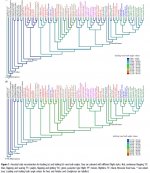albertonykus
Well-known member
Wang, X., H.K. Tang, and J.A. Clarke (2019)
Flight, symmetry and barb angle evolution in the feathers of birds and other dinosaurs
Biology Letters 15: 20190622
doi: 10.1098/rsbl.2019.0622
https://royalsocietypublishing.org/doi/10.1098/rsbl.2019.0622
There has been much discussion over whether basal birds (e.g. Archaeopteryx and Confuciusornis) exhibited active flight. A recent study of barb angles has suggested they likely could not but instead may have exhibited a gliding phase. Pennaceous primary flight feathers were proposed to show significant shifts in barb angle values of relevance to the inference of flight in these extinct taxa. However, evolutionary trends in the evolution of these barb angle traits in extant volant taxa were not analysed in a phylogenetic frame. Neither the ancestral crown avian condition nor the condition in outgroup dinosaurs with symmetrical feathers were assessed. Here, we expand the fossil sample and reanalyse these data in a phylogenetic frame. We show that extant taxa, including strong flyers (e.g. some songbirds), show convergence on trailing barb angles and barb angle asymmetry observed in Mesozoic taxa that were proposed not to be active fliers. Trailing barb angles in these Mesozoic taxa are similar to symmetrical feathers in outgroup dinosaurs, indicating that selective regimes acted to modify primarily the leading-edge barb angles. These trends inform dynamics in feather shape evolution and challenge the notion that barb angle and barb angle ratios in extant birds directly inform the reconstruction of function in extinct stem taxa.
Flight, symmetry and barb angle evolution in the feathers of birds and other dinosaurs
Biology Letters 15: 20190622
doi: 10.1098/rsbl.2019.0622
https://royalsocietypublishing.org/doi/10.1098/rsbl.2019.0622
There has been much discussion over whether basal birds (e.g. Archaeopteryx and Confuciusornis) exhibited active flight. A recent study of barb angles has suggested they likely could not but instead may have exhibited a gliding phase. Pennaceous primary flight feathers were proposed to show significant shifts in barb angle values of relevance to the inference of flight in these extinct taxa. However, evolutionary trends in the evolution of these barb angle traits in extant volant taxa were not analysed in a phylogenetic frame. Neither the ancestral crown avian condition nor the condition in outgroup dinosaurs with symmetrical feathers were assessed. Here, we expand the fossil sample and reanalyse these data in a phylogenetic frame. We show that extant taxa, including strong flyers (e.g. some songbirds), show convergence on trailing barb angles and barb angle asymmetry observed in Mesozoic taxa that were proposed not to be active fliers. Trailing barb angles in these Mesozoic taxa are similar to symmetrical feathers in outgroup dinosaurs, indicating that selective regimes acted to modify primarily the leading-edge barb angles. These trends inform dynamics in feather shape evolution and challenge the notion that barb angle and barb angle ratios in extant birds directly inform the reconstruction of function in extinct stem taxa.





